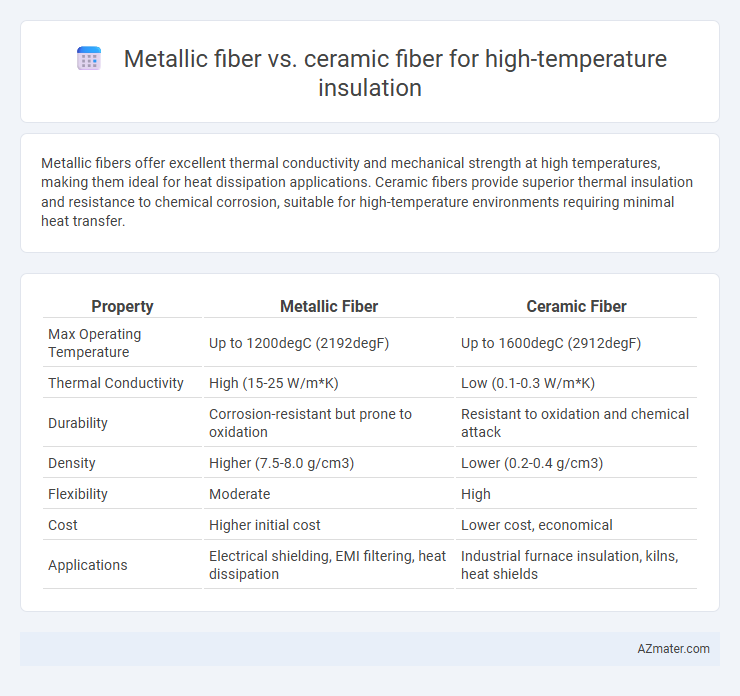Metallic fibers offer excellent thermal conductivity and mechanical strength at high temperatures, making them ideal for heat dissipation applications. Ceramic fibers provide superior thermal insulation and resistance to chemical corrosion, suitable for high-temperature environments requiring minimal heat transfer.
Table of Comparison
| Property | Metallic Fiber | Ceramic Fiber |
|---|---|---|
| Max Operating Temperature | Up to 1200degC (2192degF) | Up to 1600degC (2912degF) |
| Thermal Conductivity | High (15-25 W/m*K) | Low (0.1-0.3 W/m*K) |
| Durability | Corrosion-resistant but prone to oxidation | Resistant to oxidation and chemical attack |
| Density | Higher (7.5-8.0 g/cm3) | Lower (0.2-0.4 g/cm3) |
| Flexibility | Moderate | High |
| Cost | Higher initial cost | Lower cost, economical |
| Applications | Electrical shielding, EMI filtering, heat dissipation | Industrial furnace insulation, kilns, heat shields |
Overview of High-Temperature Insulation Materials
Metallic fibers provide excellent thermal conductivity and mechanical strength, making them ideal for high-temperature insulation in environments exceeding 1000degC, such as industrial furnaces and heat exchangers. Ceramic fibers offer superior thermal resistance and low thermal conductivity, maintaining stability at temperatures up to 1430degC, commonly used in refractory linings and fire protection. Both materials deliver distinct advantages for high-temperature insulation, with metallic fibers excelling in durability and heat dissipation, while ceramic fibers provide enhanced heat resistance and insulating performance.
What Are Metallic Fibers?
Metallic fibers are fine filaments made from metals like stainless steel, nickel, or aluminum, offering high thermal conductivity and excellent resistance to heat and oxidation. These fibers provide superior mechanical strength and durability in extreme high-temperature insulation applications, often exceeding 1000degC. Compared to ceramic fibers, metallic fibers exhibit improved flexibility and electrical conductivity, making them ideal for specialized insulation solutions in aerospace and industrial furnace environments.
What Are Ceramic Fibers?
Ceramic fibers are inorganic, non-metallic materials composed mainly of alumina, silica, and other oxides, designed to withstand extreme temperatures up to 1,400degC or higher. These fibers exhibit excellent thermal stability, low thermal conductivity, and resistance to chemical corrosion, making them ideal for high-temperature insulation in industrial furnaces and kilns. Compared to metallic fibers, ceramic fibers provide superior heat resistance and electrical insulation while offering lightweight and flexible insulation solutions.
Thermal Insulation Performance Comparison
Metallic fibers exhibit excellent thermal conductivity, making them less effective for high-temperature insulation compared to ceramic fibers, which have low thermal conductivity and superior heat resistance up to 1600degC. Ceramic fibers provide better insulating performance due to their porous structure, reducing heat transfer through conduction, convection, and radiation. Thermal insulation using ceramic fibers results in lower heat loss and improved energy efficiency in high-temperature applications such as furnaces and kilns.
Mechanical Strength and Durability
Metallic fibers exhibit superior mechanical strength and durability compared to ceramic fibers when used in high-temperature insulation, maintaining structural integrity under thermal cycling and mechanical stress. Ceramic fibers, while excellent in thermal resistance up to 1600degC, tend to be brittle and prone to cracking or erosion under mechanical load. The enhanced flexibility and resilience of metallic fibers make them ideal for applications requiring both high-temperature performance and prolonged mechanical durability.
Resistance to Chemical and Environmental Factors
Metallic fibers exhibit superior resistance to chemical corrosion and environmental degradation compared to ceramic fibers, especially in harsh industrial atmospheres involving acids, alkalis, and moisture. Ceramic fibers offer excellent thermal insulation but are more vulnerable to chemical attack and moisture-induced weakening, limiting their durability in aggressive environments. The inherent stability of metallic fibers under variable environmental factors makes them preferable for long-term high-temperature insulation applications requiring robust chemical resistance.
Weight and Flexibility Differences
Metallic fibers used in high-temperature insulation tend to be denser and heavier than ceramic fibers, impacting overall material weight in thermal protection applications. Ceramic fibers offer superior flexibility due to their fine, fibrous structure, enabling easier installation in complex shapes and tighter spaces compared to the relatively rigid metallic fibers. Weight-sensitive industries like aerospace often prefer ceramic fiber insulation for its lightweight and flexible properties, while metallic fibers are chosen for their durability and higher mechanical strength under extreme conditions.
Safety and Handling Considerations
Metallic fiber insulation offers superior durability and resistance to mechanical damage but requires careful handling due to sharp edges and potential metal allergies. Ceramic fiber insulation presents excellent thermal resistance and low thermal conductivity, yet it produces fine dust particles that pose respiratory hazards, necessitating protective equipment during installation. Both materials demand adherence to safety protocols, including ventilation and proper use of gloves and masks, to minimize occupational health risks.
Cost Efficiency and Long-Term Value
Metallic fibers offer superior durability and thermal conductivity, making them a cost-efficient choice for high-temperature insulation applications where rapid heat dissipation is critical, despite a higher initial investment. Ceramic fibers provide excellent thermal resistance and are generally more affordable upfront, but may degrade faster under extreme conditions, potentially increasing long-term maintenance costs. Evaluating metallic fiber vs ceramic fiber requires balancing initial material costs against lifespan, thermal stability, and maintenance frequency to maximize long-term insulation value.
Best Applications: Choosing Metallic vs Ceramic Fiber
Metallic fibers excel in high-temperature insulation applications requiring excellent mechanical strength, electrical conductivity, and resistance to thermal shock, making them ideal for aerospace, automotive exhaust systems, and industrial furnaces. Ceramic fibers offer superior thermal stability, low thermal conductivity, and excellent chemical resistance, best suited for kilns, power plants, and refractory linings where extreme heat and corrosive environments are prevalent. Selecting metallic fibers over ceramic fibers depends on the need for flexibility and durability under fluctuating temperatures versus ceramic fibers' advantage in thermal insulation efficiency and long-term high-temperature stability.

Infographic: Metallic fiber vs Ceramic fiber for High-temperature insulation
 azmater.com
azmater.com